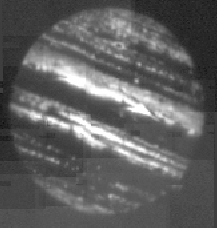 IoCam1
IoCam1
 IoCam1
IoCam1 This simple low cost camera was built in the spring of 1997 in part to be used for a
series of Jupiter mutual events, but also to serve as a prototype for future more-advanced
Wyoming cameras. It is now being used for regular Io/Jupiter occultation and eclipse
measurements as well as thermal (5 micron) observations of near-earth asteroids.
The camera was designed to serve as an efficient instrument for the Io mutual event and speckle work, and also to serve as a prototype for more advanced cameras to be developed later. We obtained state-of-the-art electronics which should be useful for those later cameras, but economized on the detector system and dewar by adapting used or surplus parts. The electronics were ordered in September 1996, assembly of the camera began in January 1997, and it was on the telescope taking data in March. The total cost excluding that of the cannibalized parts, and also excluding my time (the work was done when I was on sabbatical) was less than $30,000.
The Io occultation observations do not require a large format detector. This satellite has a maximum apparent diameter of 1.2 arcseconds, so a field that accommodates the seeing disk plus enough sky to determine the Jupiter background is sufficient. We obtained a loan of an older 58x62 InSb chip and installed it in a modified dewar previously used to hold a small discrete element bolometer array.
The Io work is carried out primarily in the 3 to 5 micron region, where the high sky background dominates the noise. In this region cooling the detector with pumped nitrogen reduces the dark current sufficiently. Using pumped nitrogen eliminates the expense of using liquid He and also eliminates the need to provide an active temperature control system. At this relatively warm temperature the dark current does begin to dominate the noise in the 2 micron region, but for the current project this is acceptable. The system was designed to allow for later modification to He cooling, if that proves desirable.
In addition to the Io work, the camera is being used to provide Jupiter images to aid the Galileo project. A 5 micron Jupiter mosaic obtained with the camera is shown above. The camera may also be used for observations of fast variable stars and for stellar occultations by planets.